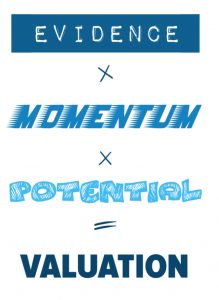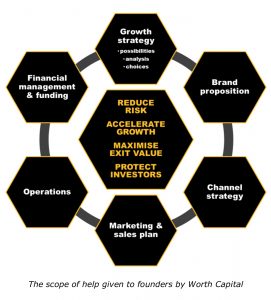The following is based on a presentation Matthew Cushen, Co-Founder of Worth Capital, gave at the VCT/EIS event in November which went down a storm with the full house that saw it; we asked him to turn it into an article for us and we’re very pleased he has
In 2008 it was the Midas touch. My first seed equity investment returned £376k from a £58k investment in only 4 years. After that result, of course my mate Paul (who had also been involved) and I continued to invest. What could go wrong? We become prolific.
We found out what could go wrong.
And had a good deal of success as well.
At the time we were investing as a hobby, with most decisions made in the pub. In a rare moment of discipline, we reviewed how, and more importantly why, we were performing and noted down some points on a back of a napkin (reproduced here – the actual napkin has long since disintegrated!).

Returning to these points a couple of weeks later, we saw valuable insight, so asked ourselves: “could we deliberately design a deal flow, a distillation process and the ongoing
support for entrepreneurs, that could stack the odds of seed investing?” And we ended up creating a unique seed investing proposition.
The same insight can also be expressed as questions that an IFA, Wealth Manager or private investor would do well to ask any EIS or SEIS fund manager – and so dig beyond the fees and compliance basics to the fund manager’s capability to deliver outsized returns.
-
What’s the scope of your investments?
Without being clear what field you are playing on, it’s difficult to play a good game. Funds that describe themselves as a tech specialist, or as a generalist consumer fund are not being specific enough. We hunt for:
Product, service & sales channel innovation in underserved and/or growth markets creating habitual consumption (B2C or B2B) and a loved brand.
Each line is important – the first line is deliberately general, but ‘innovation’ is a pre-requisite. Then that innovation needs a market within which it has room to thrive. We’ve learnt that ideas will change over time, but it is virtually impossible for a nascent business to jump from market to market.
Creating habitual consumption describes forming a sustained and strengthening relationship with customers (whether consumer or B2B). As this is what leads to building a loved brand. Brand equity creates additional exit value beyond just multiple of EBITDA or revenues. (And it happens to be what Paul and I are qualified and experienced in doing – we have deep innovation, marketing and brand building expertise).
We are deliberately not ‘tech’ focused. We’ve seen too many amazing technology solutions desperately searching around for a problem to solve and subsequently failing. However, any new business is likely to be digitally enabled. A good example is Vitrue Health. They saw that physiotherapists and orthopaedic surgeons are underserved in measuring and assessing muscular skeletal health. Currently a physiotherapist will conduct several tests over a 30-minute consultation, assessing by eye and taking notes by hand. Vitrue developed a box of depth and motion sensors that observes the same tests and immediately creates a visual and quantitative report showing joint and muscle movement with an objective and comparable set of data. Yes, this is a ‘healthtech’ product – but we were sold on the open space, the muscular skeletal health market and the potential to extend this beyond care to preventative early diagnosis.

2. What are your investment criteria?
All businesses are different, so it is critical to have criteria that define what good looks like and create objectivity when making choices between different opportunities.
We use:
A. team (25% weighting): nothing unusual here, the team being the most important element is a bit of a cliché. But then it’s worth checking the clarity of how good is defined. As well as the normal premium for industry experience we hunt for clues across:
- curiosity & empathy: an outward looking view on the world, listening intently, constantly challenging and always on the hunt for new data whether it be about customers, competitors or different business models.
- creativity & raw intellect: if curiosity is about gathering lots of dots, this is the smarts to join the dots, making the connections that led to new opportunities, sweat a business model or to solve intractable problems.
- self-motivation & proactivity: the mentality to prioritise, set plans and follow them.
- resilience & tenacity: the relentless energy & determination to grow a business and overcome the inevitable bumps, or chasms, in the road.
- charm & integrity: whether building out a loyal team, negotiating with clients & suppliers or sharing news with investors, being positive, authentic & honest is the only way to develop & maintain successful long-term relationships.
B. market (25%): we value inspirational market insight. If an entrepreneur has identified a new insight, then they have a good chance of creating a truly innovative product and/or being able to dominate a new category. And we look for space for a new business to grow.
Bedfolk is an example. It sells ridiculously comfortable bedding (sheets, pillowcases and duvet covers) manufactured in a beautiful mill in Portugal. That alone would not be solving a need. But they’d seen that the customer experience around buying bedding is very poor and even the most successful retailers like John Lewis and the White Company have single digit market shares. So they sell direct to customer – making the transaction simple and prices keen by cutting out the retailer. This is a formula that has worked in the US – with brands such as Parachute and Brooklinen growing spectacularly fast.
C. the big idea (20%): we want to see something truly innovative and different – differentiated in the market and with a proposition or business model that is protectable.
D. communication & marketing (15%): the ability to articulate a proposition clearly. If an entrepreneur can’t get it over to us, there is little chance of explaining it to customers with much shorter attention spans. Then we want to see a thought through marketing plan – clear priorities on who to target, the channels to get to them and a sense of what it would cost.
E. commercial model (15%): we don’t expect the detail of how a business makes money to always be crystal clear at the start, but we do want to see some proof points that it will be possible to create some revenue from a proposition and a rough sense that this will be greater than the cost of doing so.
3. What’s your access to exclusive & exciting deal flows?
There’s unfortunately a tendency for those with the capital to arrogantly expect those that want to get hold of it to do the running. But this old school approach results in funds fishing in a small pond and often competing over the same deals (and so increasing valuations).
We wanted to put ourselves in front of entrepreneurs and make it easy and attractive for them to approach us. So we created a competition series called ‘The Start-Up Series’. It’s promoted nationwide by www.startups.co.uk. It gives us unique deal flow beyond the London bubble.

Whilst 73% of seed funding goes to businesses inside London (source: The Deal, Beauhurst, published February 2020), 60% of our funding is directed outside of London. An example is Uniblock, founded by Les, a 55 year-old ex-Army guy – not the stereotypical entrepreneur. He has now established a factory in Scunthorpe employing 22 people manufacturing a highly insulating, quick to erect, building material. After only 3 years it is already 4 times the value of our initial investment.
4. How systematic & bias free is your assessment?
Unfortunately, Paul and I are like most other investors – greying, white, middle class and living in the South East. We’ve deliberately designed a distillation process to, as much as we can, remove our inherent bias.
First we say ‘ditch the pitch’. It is remarkable how this cliched, ineffective and lazy way of judging ideas, businesses (and, with speed dating or Tinder, even romance) has ingrained itself. We have a six step process we follow each month that distils our competition entries (generally 60 to 100 per month) down to 3 or 4 business with whom we devote half day sessions to really get under the skin of the strategy, proposition, marketing plan, financials, operating model etc.
Sadly, only 9% of early stage funding goes to businesses with a female founder (source: The Deal, Beauhurst, published February 2020). Without any positive discrimination, 40% of our funding has been directed to businesses with a female founder. ‘Ditching the pitch’ may remove a bias towards bravado and confidence that many believe disadvantages women pitching to a room full of men. Or it may be our obsession with market insight – there is some science that says women are more empathetic and so able to spot different insight. Randa and Patricia, mothers and founders of VeeLoop illustrate this. VeeLoop is an online approval and payment service to help tweens and teens shop and subscribe online, whilst Mum and Dad maintain control. It helps retailers to reduce basket abandonment and to stay the right side of GDPR and legal considerations when transacting with kids. The founders’ empathy with the problem to solve got them to properly innovative solution.

5. How do you agree fair valuations?
Valuing a start-up is only vaguely related to the science of valuing an established business – there is not enough earnings data to make objective calculations. First Chicago/Venture Capital, Berkus, Risk Factor Summation or other such valuation methods are useful and objective if there is good disclosure and availability of risk data. But we believe valuing a start-up is much more of a conversation – to get to something that is fair for investors and motivating for founders.
We have this simple framework that helps structure the conversation and keep both parties objective with matters of subjectivity. It is a qualitative framework not a quantitative equation, but one maths principle is deliberate. It has multiplication signs, not plus signs. If any of these elements are missing the result should be zero.

Evidence: the proof points the start-up has that their proposition is going to be interesting and valuable to the target market. Ideally there will be some actual customers and revenue. But even at an earlier stage than that, any idea should have insight and research to back it up.
Momentum: seeing the founders have built up a head of steam, can deliver on promises made and have a clear plan for the next steps.
Potential: of course, early stage businesses are all about potential. Making this as real as possible helps to quantify value, for example, product development pipeline or letters of intent or contracts from future customers.
Too many valuations currently are overweighting the value of potential, based purely on a great idea with very little in the way of evidence or momentum. This seems to be particularly true of crowdfunding, probably as there is not a proper conversation between entrepreneur and investors. This framework – usually further backed up with numbers and projections – keeps us objective. It keeps us from getting swayed by what’s hot and from blindly following the market.
6. How do you reduce risk, accelerate growth & maximise value?
There is an interesting divide opening within the seed investment market. There are funds operated by financial services professionals, possibly with strong brands built in a different asset class. Then there are now more early stage investing funds run or advised by commercial and entrepreneurial types that have themselves built businesses.

Our sense is that it ‘takes one to know one’ – with commercial entrepreneurs being better qualified to spot markets, ideas and teams with the best potential. But then also they are best able to help the founders of new businesses to reduce risk, accelerate growth and maximise exit value – along with providing the oversight and protection for investors.
We get properly ‘sleeves rolled-up’ with our investments. Not just taking a board seat but digging deep into areas where an entrepreneur needs the benefit of our experience and battle scars.
An example here is Weekly10. It is a very smart way for any business to measure and track sentiment and engagement within their organisations. The market is huge – literally any business, in any country, in any sector that employs people. So, the challenge is to prioritise segments for which marketing effort and investment is likely to deliver the best return. We started to help the founder to do that even as we were assessing the business. And have continued to do so alongside other help on pricing, communications, experience design etc.
7. When do you deploy & how do you build portfolios?
Unfortunately, there are examples of EIS & SEIS funds not deploying investment capital in a timely way, or even within the tax year expected. The answer to this really goes back to deal flow, if it is regular, sustained and throwing off quality investments then a fund should be able to deploy regularly. But the proof is in the performance over the last couple of years.
The time it takes a fund to process EIS and SEIS tax certificates is also a valuable clue about client service. Although we are at the mercy of HMRC for part of the process, it really isn’t that difficult. We are now always below 60 days. And for our last portfolio of 4 investments in January this year we had certificates to investors within 24 days.
Building diversification in a portfolio is essential for seed investing. Some businesses will fail but portfolio returns are driven disproportionately by the multiples achieved by those that exit. Because the scope of our investing is wide, our mini-portfolios are cross sector, and cross B2C and B2B. We also have an eye on the maturity and risk across the portfolio. Sometimes there will be a ‘moonshot’, such as Zobi – a hardware and software product to detect rogue communications between devices on a network (for example, questioning why your smart coffee machine is sending an instruction to open your smart lock on your front door). But any ‘moonshot’ with the potential for very large multiples would be balanced by less adventurous choices.
About Matthew Cushen
Matthew Cushen is an innovation consultant, entrepreneur and successful angel investor. He is Co-founder of Worth Capital. The Start-Up Series Fund, created by Worth Capital and managed by Amersham Investment Management, invests in the monthly winners of the Start-Up Series. The minimum investment is £10,000.
















